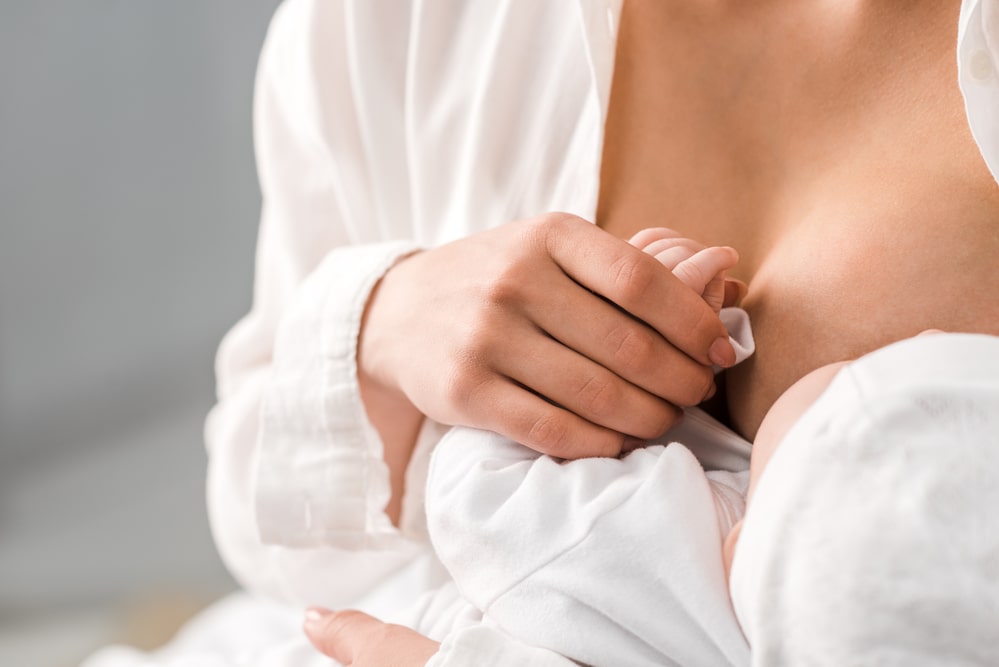Breastfeeding is said to be the most natural way to feed your baby but there is far more to it than just letting nature run its course.
Breastfeeding can be exhausting and draining both mentally and physically on a mom and her body. But the key to making this journey as stress-free as possible is ensuring that right from the start your baby has a good latch.
For many women, this is not the case and they have to deal with some uncomfortable and often painful breasts and nipples as a result.
Lipstick nipple is one of these consequences of a poor latch and although not painful or uncomfortable for mom it can have serious consequences on her breastfeeding journey.
What Is Lipstick Nipple?
Lipstick nipple is a common problem for breastfeeding mothers and it is something that can be corrected.
If you are suffering from a lipstick nipple, you may notice that when your baby has finished feeding your nipple may have a flattened appearance. It looks a little like the slanted side of a new lipstick hence the name ‘lipstick nipple’.
This occurs when your baby’s latch is not deep enough and this can cause problems. But having a lipstick-shaped nipple after feeding is normally a painless problem and thankfully it can be fixed.
Why Is Lipstick Nipple a Problem?
This is a result of your baby not having a deep enough latch and this can cause problems over time. A bad latch can cause several issues such as:
- Failure to thrive
- Slow growth
- Shallow latch – this can lead to painful nipples.
- Insufficient milk supply.
So when you are seeing this lipstick nipple after each feed, then you know something needs to be done.
How To Fix Lipstick Nipple
View in gallery
The key to correcting this problem is to ensure that your baby is getting a deep latch each time that they breastfeed. Having skin-to-skin helps your baby to get this deep latch, but this is not always possible.
Here is one way to help your baby get a deep latch and it is not as difficult as you may think.
- Ensure that your baby is fully supported. This can be done by keeping your hand between your baby’s shoulder and your fingers at the base of their head.
- Use your other hand to cup your breast. Forming a C with your thumb and fingers, but make sure that you keep your fingers away from your nipple.
- Make sure that your baby is facing towards you, his head should be faced forward with his chin slightly tilted upwards.
- To encourage your baby to latch deeply, point your nipple towards their nose, this will make them naturally lift their chin and open their mouth widely.
- You need to aim your breast towards the roof of your baby’s mouth and let them latch on to the breast.
How To Know If You Have A Good Latch
It can be difficult to tell if your baby has a good latch purely based on whether you can hear them drinking and swallowing.
Some babies are tricky and will often make those sounds even when they are not doing either this is why it is not the best indicator of a good latch.
You know that you have a good latch if:
- Your baby’s chin is touching your breast first.
- The bottom of their lip should be further out from the base of the nipple then the top lip. Your baby’s lips should be curled outwards.
- Their nose may touch your breast, but they should still be able to breathe properly.
Different Ways Breastfeeding Can Affect Your Nipples
Certain changes to your nipples could indicate that breastfeeding is not going as well as you hoped it would, while others are purely cosmetic.
Here are some things that breastfeeding can do to your nipples:
Sore, cracked, or bleeding nipples
Many mothers are led to believe that sore, cracked, and bleeding nipples are a simple part of the course when you breastfeed. But this is not true, if your baby has a good latch then you should not be suffering from any of these issues.
If breastfeeding is painful you may want to consult a lactation consultant to help you get a good latch.
Change of color
If after feeding your nipple is white, this is also known as blanching, it could be a sign that your baby isn’t latching and could be cutting off the blood supply to your nipple.
This is called vasospasm and is often accompanied by burning, stinging, or shooting pain.
Fixing the latch issue will usually fix the vasospasm too. But vasospasm can also be a sign of Raynaud’s disease and not be related to breastfeeding at all.
Painful blisters on the nipple
Milk blisters can be white, clear, or yellow and look like a tiny pimple on your nipple. They can be extremely painful.
They are caused by milk getting backed up behind a milk duct opening, this can lead to blocked milk ducts and potentially lead to mastitis.
These blisters can more often than not be treated at home with a warm washcloth and saline solution.
View in gallery
Thrush
Thrush is a yeast infection that you can get on your nipple or your baby can get in their mouth or both. Symptoms would be itchiness, pain, or white flakes and your baby may have white cheese-like patches in their mouth.
Nipples may appear bigger
Some women have very flat or slightly inverted nipples which can get drawn out once your baby latches on and begins feeding. Your nipples didn’t really grow but were dawn out by your baby feeding. Once out it is likely that they will stay this way.
Dark or bumpy areolas
The circular area of pigmented skin around your nipples is called the areolas.
During pregnancy, you may have noticed that they have developed some small bumps and that they may have even got a little darker. This is called Montgomery’s tubercles.
Droopy nipples
This is one lasting effect of breastfeeding in that your nipples might look droopy or hang a little lower than previously.
I understand that you may not be entirely happy with your new look but try to remember that you birthed and fed a baby! Your body is amazing no matter how it’s changed.
Many moms may opt to express their breastmilk, allowing someone else to take over the feeding as well as giving their sore nipples a little break. Check out our bottle reviews here.
If you are thinking of expressing your milk then you are probably wondering what type of pump is best, check out our article Manual vs Electric for all the information you will need.
FAQs
View in gallery
How do I stop nipple compression?
You can prevent nipple compression by holding your breast between your index and middle fingers while latching on ensuring that you are not holding too close to the nipple.
Sometimes shaping your breast with your hand to match the shape of your baby’s mouth can also help.
What is the Flipple technique?
The Flipple technique is when you try to get as much breast tissue in your baby’s mouth as possible.
This can be achieved by pointing your nipple high towards their nose, try to get as much of the bottom part of your areola into your baby’s mouth, and then use your finger to flip their top lip up after they have latched on.
How long does it take for nipples to get used to breastfeeding?
Nipple sensitivity increases during pregnancy and peaks about 4 days after giving birth.
You may notice pins and needles in your nipples when your baby begins nursing that lasts for around 30 seconds. This usually resolves itself by the time your baby is around 1 week old.
The Final Thought
These techniques can help to correct lipstick nipple. But good technique from the beginning, with a good latch, will help to prevent the issue and ensure that your breastfeeding journey is as stress-free as possible.






